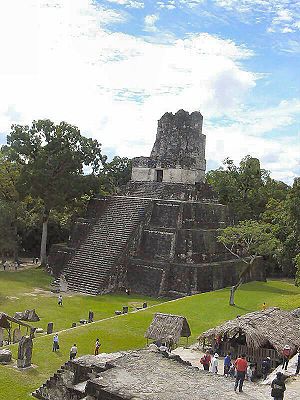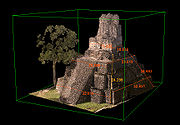
Tikal Temple II
Encyclopedia

Mesoamerican pyramids
Mesoamerican pyramids, pyramid-shaped structures, are an important part of ancient Mesoamerican architecture. These structures were usually step pyramids with temples on top – more akin to the ziggurats of Mesopotamia than to the pyramids of Ancient Egypt...
at the Maya
Maya civilization
The Maya is a Mesoamerican civilization, noted for the only known fully developed written language of the pre-Columbian Americas, as well as for its art, architecture, and mathematical and astronomical systems. Initially established during the Pre-Classic period The Maya is a Mesoamerican...
archaeological site of Tikal
Tikal
Tikal is one of the largest archaeological sites and urban centres of the pre-Columbian Maya civilization. It is located in the archaeological region of the Petén Basin in what is now northern Guatemala...
in the Petén Department of northern Guatemala
Guatemala
Guatemala is a country in Central America bordered by Mexico to the north and west, the Pacific Ocean to the southwest, Belize to the northeast, the Caribbean to the east, and Honduras and El Salvador to the southeast...
. The temple was built in the Late Classic Period
Mesoamerican chronology
Mesoamerican chronology divides the history of pre-Columbian Mesoamerica into several periods: the Paleo-Indian , the Archaic , the Preclassic , the Classic , and the Postclassic...
in a style reminiscent of the Early Classic. Temple II is located on the west side of the Great Plaza, opposite Temple I
Tikal Temple I
Tikal Temple I is the designation given to one of the major structures at Tikal, one of the largest cities and archaeological sites of the pre-Columbian Maya civilization in Mesoamerica. It is located in the Petén Basin region of northern Guatemala...
. Temple II was built by the king Jasaw Chan K'awiil I in honour of his wife, Lady Kalajuun Une' Mo'
Lady Twelve Macaw
Lady Twelve Macaw was a Mayan Queen of Tikal as a wife of the King Jasaw Chan K'awiil I. She was a mother of the King Yik'in Chan K'awiil....
. Temple II had a single wooden sculpted lintel that bears the portrait of a royal woman who may have been the wife of Jasaw Chan K'awiil I, who was entombed beneath Temple I. Lady Kalajuun Une' Mo', whose name means "Twelve Macaw
Macaw
Macaws are small to large, often colourful New World parrots. Of the many different Psittacidae genera, six are classified as macaws: Ara, Anodorhynchus, Cyanopsitta, Primolius, Orthopsittaca, and Diopsittaca...
Tails", was also important for being the mother of Jasaw Chan K'awill I's heir. In fact her son Yik'in Chan K'awiil
Yik'in Chan K'awiil
Yik'in Chan K'awiil was a Mayan ruler in the Late Classic period of the city-state polity centred at Tikal, a major pre-Columbian Maya site in the Petén Basin region .-Biography:Identified by Mayanist epigraphers as the 27th ruler in Tikal's dynastic succession, Yik'in Chan...
oversaw the completion of Temple II when he became king.
Temple II was visited by Modesto Méndez, the governor of Petén, in 1848 on the first expedition to the ruins. Preliminary excavations of Temple II started in 1958.
The structure
The pyramid is a squat, massive structure dating to the 8th century AD. Today it stands 125 feet (38.1 m) high and is the most thoroughly restored of the major temples at Tikal. Its original height would have been closer to 42 metres (137.8 ft) including its roof combRoof comb
Roof comb is the structure that tops a pyramid in monumental Mesoamerican architecture. Examination of the decorations and iconography of Maya civilization roof-combs indicates that each icon had specific sacred meanings.-External links:...
. The main stairway is 10.4 metres (34.1 ft) wide and projects 7.45 metres (24.4 ft) from the pyramid base. The base of the pyramid measures 37.6 by, covering a surface area of 1542 square metres (16,597.9 sq ft). Excavations inside Temple II failed to discover Lady Kalajuun Une' Mo's tomb. Ancient graffiti within the temple shrine depicts a captive upon a platform and bound between two poles being sacrificed with an arrow or a spear. Further ancient graffiti includes images of temples. Some of this graffiti dates to the Classic Period, although other examples appear to date to the Early Postclassic. The interior walls have also been defaced with modern graffiti. Evidence of ritual use in the Postclassic Period was found within the temple shrine, including burials and offerings.

The roof comb of the temple is highly ornate and bears the sculpture of a face with circular earspools
Plug (jewellery)
A plug , in the context of body modification, is a short, cylindrical piece of jewellery commonly worn in larger-gauge body piercings. Because of their size—which is often substantially thicker than a standard wire earring—plugs can be made out of almost any material...
. Various sealed chambers exist within the roof comb.
The temple shrine upon the summit of the pyramid contains three chambers, the doorways of which were spanned by lintels. Only the lintel over the middle doorway was carved. The lintel consisted of five wooden beams, one of which is now in the American Museum of Natural History
American Museum of Natural History
The American Museum of Natural History , located on the Upper West Side of Manhattan in New York City, United States, is one of the largest and most celebrated museums in the world...
in New York. When excavated the lintels had fallen from their original positions and have been restored.
At the base of the main access stairway stands Stela
Stele
A stele , also stela , is a stone or wooden slab, generally taller than it is wide, erected for funerals or commemorative purposes, most usually decorated with the names and titles of the deceased or living — inscribed, carved in relief , or painted onto the slab...
P-83, which was plain, without sculpted decoration or hieroglyphic texts
Maya script
The Maya script, also known as Maya glyphs or Maya hieroglyphs, is the writing system of the pre-Columbian Maya civilization of Mesoamerica, presently the only Mesoamerican writing system that has been substantially deciphered...
. The stela stands 3.34 metres (11 ft) high and was broken but has been restored. It is associated with its respective altar. The distance from the base of the main stairway of Temple II, across the plaza to the base of the stairway of Temple I directly opposite is 70 metres (229.7 ft).
See also
- El Castillo, Chichen ItzaEl Castillo, Chichen Itza;El Castillo , also known as the Temple of Kukulkan, is a Mesoamerican step-pyramid that dominates the center of the Chichen Itza archaeological site in the Mexican state of Yucatán...
- Pyramid of the MagicianPyramid of the MagicianThe Pyramid of the Magician is a Mesoamerican step pyramid located in the ancient, Pre-Columbian city of Uxmal, Mexico. The structure is also referred to as the Pyramid of the Dwarf, Casa el Adivino, and the Pyramid of the Soothsayer...
at UxmalUxmalUxmal was dominant from 875 to 900 CE. The site appears to have been the capital of a regional state in the Puuc region from 850-950 CE. The Maya dynasty expanded their dominion over their neighbors. This prominence didn't last long... - Temple of the InscriptionsTemple of the InscriptionsThe Temple of the Inscriptions is the largest Mesoamerican stepped pyramid structure at the pre-Columbian Maya civilization site of Palenque, located in the modern-day state of Chiapas, Mexico. The structure was specifically built as the funerary monument for K'inich Janaab' Pakal, ajaw or ruler of...
at PalenquePalenquePalenque was a Maya city state in southern Mexico that flourished in the 7th century. The Palenque ruins date back to 100 BC to its fall around 800 AD... - Tikal Temple IIITikal Temple IIITikal Temple III, also known as the Temple of the Jaguar Priest, was one of the principal temple pyramids at the ancient Maya city of Tikal, in the Petén Department of modern Guatemala. The temple stands approximately tall. The summit shrine of Temple III differs from those of the other major...
- Tikal Temple IVTikal Temple IVTikal Temple IV is a Mesoamerican pyramid in the ruins of the ancient Maya city of Tikal in modern Guatemala. It was one of the tallest and most voluminous buildings in the Maya world. The pyramid was built around 741 AD. Temple IV is located at the western edge of the site core...
- Tikal Temple VTikal Temple VTikal Temple V is the name given by archaeologists to one of the major pyramids at Tikal. Tikal is one of the most important archaeological sites of the pre-Columbian Maya civilization and is located in the Petén Department of northern Guatemala....

